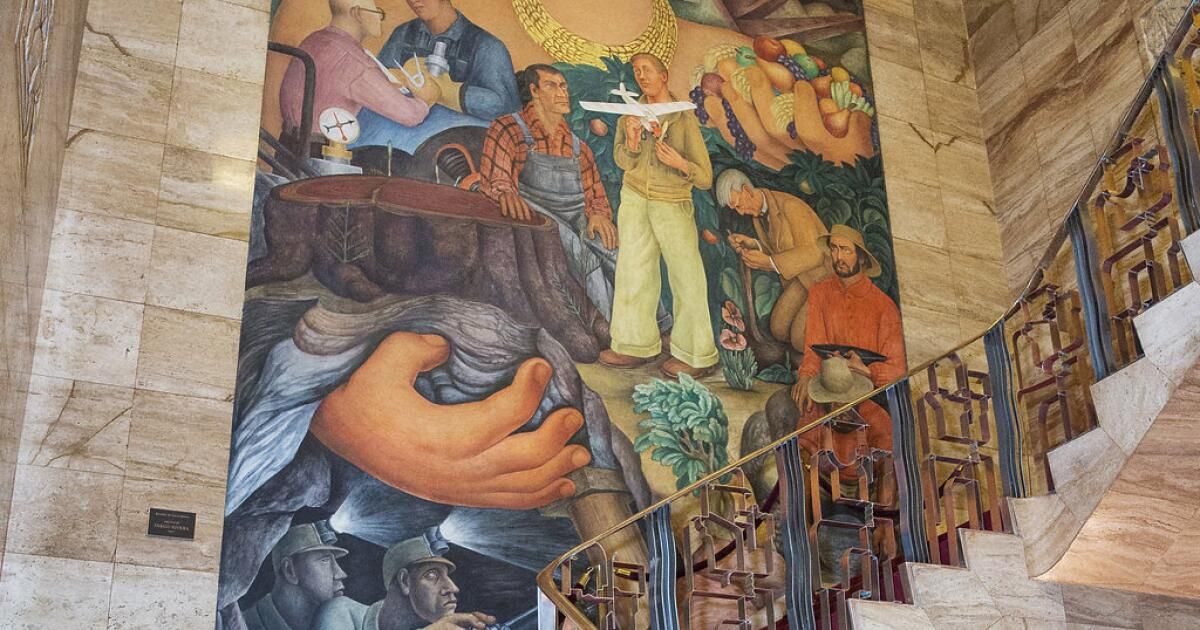A mural by Diego Rivera titled “The Allegory of California” is hidden in a private staircase inside the City Club of San Francisco. It depicts a woman often referred to as the spirit of California and the generosity she offers: a cornucopia of workers and her promise of progress.
The industry and extraction on display here convey a version of California history, the version long reinforced in schools, in which much of California's origin story has been wrapped up in the gold rush. However, the woman at the center of the mural represents a much older theme, woven throughout the history of Europe and Africa, inadvertently captured in fiction 500 years ago, which was repeated in North America and gave rise to the state we know today. .
Rivera's painted woman's face was based on Olympic gold medalist Helen Wills, but the character is inspired by “The Adventures of Esplandián,” a 16th-century novel by Castilian author Garci Rodríguez de Montalvo. The story's antagonist, Calafia, is the powerful Muslim queen of a distant land of bounty called California. She sails into battle with an army of women, fighting against the Spanish army, represented as forces of good and Christianity.
Montalvo had spent his youth as a soldier in the army of Ferdinand and Isabella, the famous royal duo who expelled the Muslim rulers from the Andalusian peninsula in 1492, the same year their explorer Christopher Columbus arrived in North America. When Montalvo wrote his later fictional battles, he drew explicitly on those Andalusian wars.
Scholars speculate that his Queen Calafia is based on a real Muslim queen who began a pirate career as revenge against the Spanish kingdom that had driven her family from their ancestral home to the mountains of Morocco. This was Sayyida al Hooray.
She rose to power in the early 16th century and became an independent queen in the Moroccan city-state of Tetouan. Either she became a privateer herself and headed to the Mediterranean Sea to attack Spanish properties such as Gibraltar, or she granted licenses to privateers to attack Spain in her name. She was an ally of the pirate and Ottoman leader Khayr al-Dīn, better known in the West as Barbarossa or Red Beard. She harassed the Spanish and Portuguese royal navies, simultaneously enriching her people and ensuring that the Spanish knew that her cruelty had not been forgotten or forgiven.
It's not entirely certain that this Moroccan pirate queen was the inspiration for Montalvo's fictional queen, but the resemblance is striking. Both were powerful and independent Muslim women who fought bravely against the Spanish on land and water. And both fell from power.
Al Hurra was dismissed by her son-in-law. In Montalvo's story, Queen Calafia is captured by the Spanish. She is Christianized, married and domesticated. When she is freed, she vows to return to her homeland and dissolve the power structures that value women's perspectives, so that the land of California favors masculine and Christian power.
The story of the Spanish victory was a sensation in Spain. The oldest surviving copy, from 1519, shows that it went through many editions and reprints. When the Spanish conquistador Hernán Cortés made his last expedition in 1536 and saw the western coast of North America, he called it California., borrowing the name from Montalvo's romance.
The name stuck. Centuries later, just as the gold rush began, part of the coast became the state of California in 1850. The link to the 15th century Spanish wars against the “infidels” may have gone unnoticed by American leaders of the 15th century. XIX, but now we can see how Calafia reflects the disturbing history of colonization and domination that created California.
Like the tales of Queen Calafia and Sayyida al Hurra, California history revolves around European invasion and displacement. Spanish colonizers invaded the west coast, eventually capturing and forcibly Christianizing the Chilula, Chimarike, Karok, Shasta, Tolowa, Wiyot, and Yurok tribes. People were driven from their ancestral lands in violent ways that disrupted entire cultures. In the name of progress, much was lost and destroyed. Their stories were erased in favor of myths of European “discovery,” American exceptionalism, and Christian destiny. For the winner, the creation of myths. But when those victors named California, they incorporated more into the mythology than they intended.
Google Books, which can track the appearances of a particular word or phrase in written sources between 1500 and 2019, shows that the use of “Calafia” has increased in a pattern that reflects interest in California history at various points in time. Usage has increased in recent years, reflecting an interest in highlighting the influence of marginalized peoples in American history. The upward trajectory in 2019 hints at the surge in interest in marginalized stories that would occur in 2020 alongside the Black Lives Matter movement.
The steep peak circa 1926 foreshadowed Rivera's use of Calafia in his mural in the early 1930s. Intentionally or not, Rivera's description of the Spirit of California is eerily in line with how Montalvo's story ends : In addition to the imposing queen, the mural mainly depicts men whom she holds in her arms; Her work comes from her support and offering. The face of the once powerful Muslim queen, transformed into the image of a beautiful white tennis player, exists only as a symbol of beauty and progress.
Centuries of retellings seem to have stripped the story of Al Hurra's life of its power as an African queen, as an avenging pirate. She became the Calafia of Montalvo, subdued by Spain. Calafia became the spirit of Rivera's California, a backdrop for the men who felled trees and exploited mines. This figure's arc through history and fiction traces the destruction of female and indigenous power in favor of white Christian patriarchy. A California allegory indeed, and one that only recently seems to be coming to an end.
Valorie Castellanos ClarkLos Angeles writer and historian, is the author of the upcoming book “Rebel Figures: Twenty Stories of Rebels, Lawbreakers, and Revolutionaries You've (Probably) Never Heard of.”











